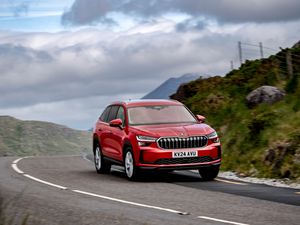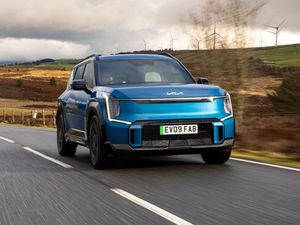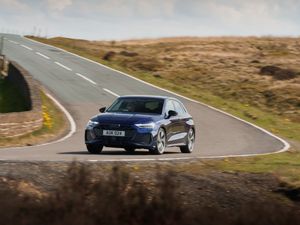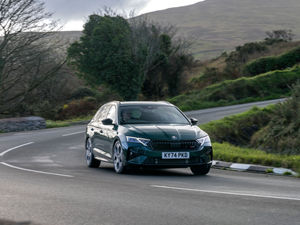Triple test: Aston Martin Vanquish S Volante V Mercedes-AMG GT C Roadster V Audi R8 Spyder V10 Plus
It’s time to compare three high-powered, soft-top supercars. Let battle commence.
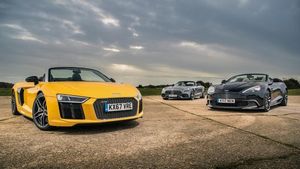
What are they?

We’ve got three big hitters here, and all come with a folding roof. Though convertibles may not be the most practical of cars, they’re hugely popular here in the UK – despite the weather. Up first is the Mercedes-AMG GT C Roadster, a V8-powered old-school muscle car with as much charisma as you could possibly get from something with four wheels.

Next comes the all-conquering Audi R8 Spyder V10 Plus. With a sonorous V10 engine mounted in the middle and quattro all-wheel-drive keeping the whole thing in check, it’s a soft-top version of what is usually claimed to be one of the best everyday supercars money can buy.
Finally, representing the old-school is the Aston Martin Vanquish S Volante. With classic looks and a powerful V12 engine under the bonnet, it’s the least technology-laden car here – though that’s no reason to write it off just yet.
What’s new?
All three cars stand at the very top of the automotive food chain, bringing with them the very latest mechanical developments.

The Mercedes features a real example of engine downsizing without forsaking performance. Its V8, though only four litres in capacity, produces 550bhp driving the rear wheels only through a seven-speed gearbox. It’s a masterclass in how brutal power figures can be produced even when losing engine capacity. It also incorporates all-wheel-steering, a feature we’re seeing applied more and more to supercars in order to afford them with better low-speed maneuverability and improved high-speed stability.
The Aston Martin, meanwhile, isn’t as forward-thinking as the Merc when it comes to engines. A naturally-aspirated V12 gets things going, but despite being far larger than the GT C’s V8, produces just over 40bhp more. That said, carbon-fibre has been used for every external panel, keeping weight low but rigidity high.

The Audi R8 V10 Plus completes the trio. Despite having its roof lopped off, it remains impressively rigid, while this Plus model benefits from added performance-related trinkets such as ceramic brakes, extra carbon-fibre trim and more power over the regular R8 Spyder – an extra 69bhp in fact.
What’s under the bonnet?
The engine is the key to the character of a supercar. Flat engine, flat personality – it’s as simple as that. Thankfully, our three here all feature hugely characterful powertrains.

The V12 in the Aston Martin may lack the turbocharging or downsizing of ‘modern’ supercar engines, but what it offers in response is the most amount of drama you could possibly get from a set of cylinders. It shrieks on start-up, and continues howling throughout the rev range while deploying its 580 horses. The sprint to 60mph takes just over five seconds, and it’ll carry on accelerating all the way to top speed of 201mph.
The Mercedes, incidentally, uses the same engine that features in the next-generation of Aston Martins – a turbocharged 4.0-litre unit with those turbochargers nestled inside the ‘V’ of the engine for better response. It produces 550bhp and 680Nm, driving power to the rear wheels via a seven-speed DCT gearbox. However, whereas the Aston’s V12 is all about top-end performance, the Merc’s V8 relies on low-down grunt and, thanks to that considerable torque figure, there’s plenty of it.

The R8 Spyder’s V10 has a similar character to the Aston’s V12 – it loves to be revved out, rather than relying on low-down torque like the Mercedes.
What are they like to drive?
Of course, all three here offer up an exceptionally good driving experiences. But it’s subtle differences between them which create completely different characteristics. The AMG’s steering, for instance, is far quicker than you’d expect to accompany a car of this size. It takes a little getting used to, but it means that it feels agile and eager to change direction. The Audi’s, in contrast, feels solid and predictable – as you’d expect from an Ingolstadt product – and this makes it exceptionally confidence-inspiring. It does, however, make it feel perilously close to a regular Audi – though one with a huge amount of punch.

The Vanquish steers in a predictably old-school way. The wheel has plenty of weight to it, and the car’s changes in direction are undertaken with minimal fuss – though being rear-driven, it’ll still happily let you know when you’re starting to take liberties. It feels heavier to drive than the other two, and there’s good reason for this – at 1,919kg it trumps the Audi and Mercedes’ 1,695kg and 1,735kg respective kerb weights by some margin. Blame that on older building techniques and that V12 sat up front – though powerful, it’s extremely heavy.

Up and running, the Mercedes feels the most frenetic of the three. It’s a little wilder than the other two, and, when coupled with its powerful V8, feels every bit the modern day muscle car. Treat it without the proper respect and you’ll very quickly find yourself spinning out like an ice skater with their shoes on the wrong feet. However, drive neatly and carefully and it is a car you can quickly find a rhythm in. Funnily enough, it has the same characteristics as the more track-focussed AMG GT R, with which it shares many parts.

The Audi is almost too easy to drive, even in cold weather such as that we found on our shoot day. Though tyres struggle to find temperature and therefore grip, the Audi manages to be capable and confidence inspiring at all times. The Spyder is just as easy to drive as the coupe, and the shifts offered by its seven-speed S-Tronic are crisp on both up and downshifts.
How do they look?
All car enthusiasts can appreciate a supercar – but it’s the way that this trio is appreciated by the general public which shows you how people feel about them. The Mercedes, for instance, was met with a variety of knowing nods.

The Aston was the clear public favourite, with any passer-by quickly admitting that it was the one they’d take home if they could. The Audi, meanwhile, was somewhat of a mixed bag; some loved the bright yellow paintwork and over-the-top exhaust note, while others thought it was just too ostentatious. But then cars like these aren’t mean to please everyone, after all.
What are they like inside?


The cabin quality in the Audi, meanwhile, is solid and, well, German. It’s also the source of our main criticisms about the R8 Spyder – the seating position. Most likely owing to the conversion from hard-top to soft-top the cabin has become shorter, which makes it incredibly cramped. It leaves you driving with your knees up high, and this can be quite tiring over longer periods – not what you want from an everyday two-seater. You can get the steering wheel where you want it, but an inability to sit in the proper position does spoil the overall driving experience.

In contrast the Mercedes is a comfortable place to be. There’s no denying that the high dashboard and monstrously large central tunnel can make it feel slightly intimidating, but once you’re up and running it’s a quick process to get acquainted. The main controls are, however, laid out without any rhyme or reason and there are a variety of buttons that feel straight from the parts bin; the window switches, for instance, feel fresh from a mid-2000s E-Class.
What’s the spec like?
All three supercars benefit from plenty of standard kit – though you’d expect that from halo cars. The Audi’s infotainment system, using the brand’s Virtual Cockpit, is easily the most user-friendly here. It’s clear and easy to read, and is just the same as you’ll see on other, more down-to-earth cars in the range. That’s no bad thing – it works, and works well.
The Mercedes gets the firm’s latest infotainment system, but its rotary controller lacks the ease of use the Audi offers. It’s clear and simple, though even pairing your phone to the car’s system isn’t as simple as in the R8.
Lastly, there’s the Aston. Unfortunately, its on-board system lags someway behind the other two here. It’s slow to respond and difficult to navigate – something you’d not expect from a car in the price range. The stereo offers a decent sound, but the overall infotainment does let the side down.
Verdict
All three cars here would be an admirable choice if you were after a new supercar. The Aston Martin is a last bastion of old-age V12 mechanicals, offering audible thrills that are unlikely to be with us for much longer. For that, it’s worthy of a huge amount of praise indeed.
The Audi is a masterclass in how to create a fast, flamboyant and well-made supercar that you can genuinely drive each and every day. However, its shortened cabin is a genuine fault here and one which is hard to look past – particularly if you’re anything over five foot seven.

Finally, there’s the Mercedes. It’s one of the spikier cars to drive on this list, but that’s what makes it exciting to get behind the wheel. There are niggles – interior build quality for one – that bring it down a touch, but it’s a genuinely special place to be.
I think you can probably see which way we’re leaning here. The AMG GT C Roadster, with its knuckleduster attitude and frankly rude performance is the one we’d go for. It’s comfortable, relatively practical but, more than anything, it’s exciting. In this segment, excitement is key – which is why the Mercedes is our deserved winner.

